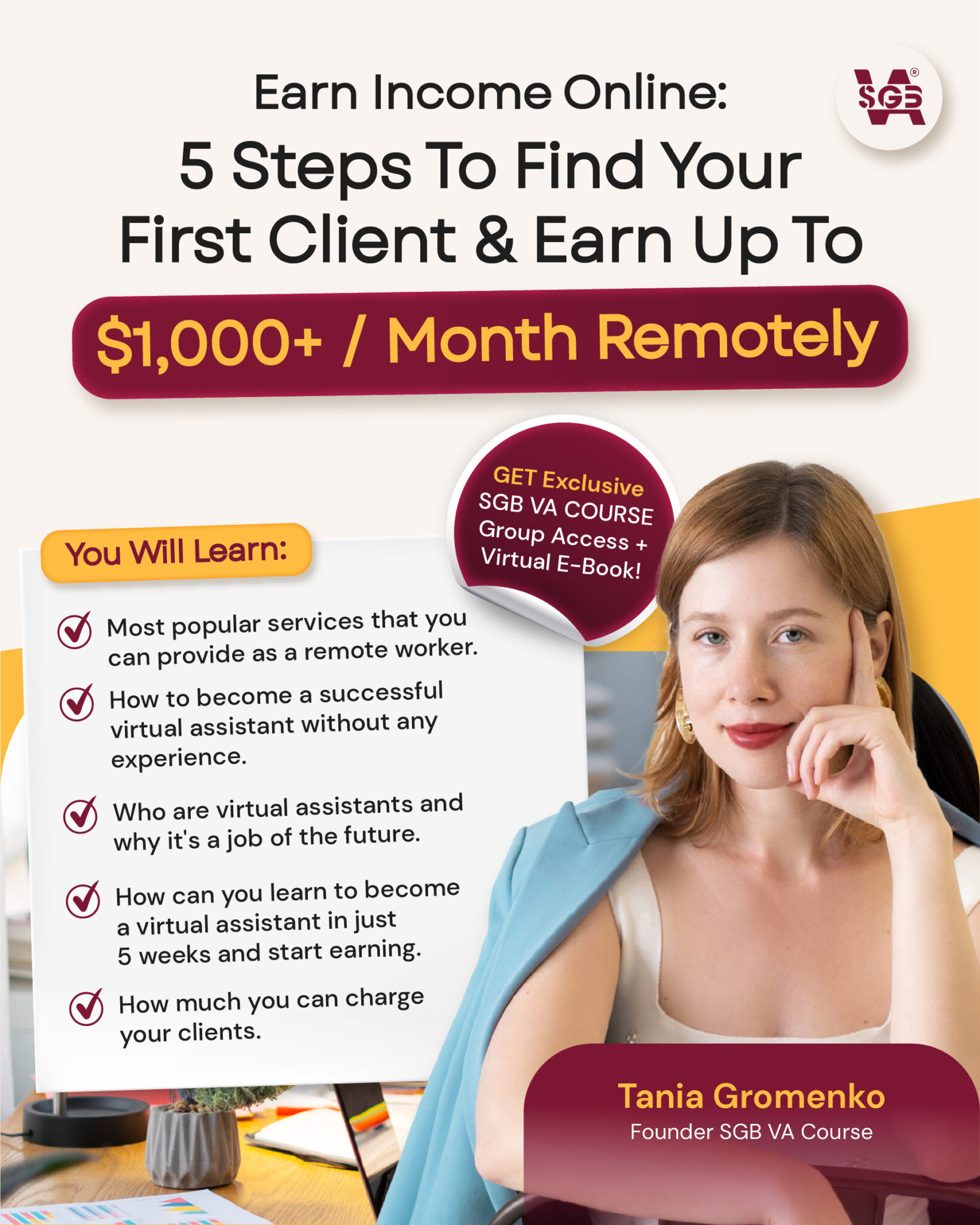8 Lowongan Kerja Sampingan untuk Ibu Rumah Tangga, Bisa Dikerjakan dari Rumah!

8 Lowongan Kerja Sampingan untuk Ibu Rumah Tangga, Bisa Dikerjakan dari Rumah! Athika Rahma SEO Specialist Virtual Assistant at SGBVA February 24, 2025 Alumni Stories Menjadi ibu rumah tangga bukan berarti harus mengesampingkan peluang untuk berkembang dan mandiri secara finansial. Banyak pekerjaan sampingan yang bisa dijalankan dengan waktu yang lebih fleksibel, memungkinkan ibu untuk tetap mengatur rumah tangga sekaligus mendapatkan penghasilan tambahan. Mulai dari berjualan online, menawarkan jasa kreatif, hingga bekerja sebagai asisten virtual, ada banyak pilihan yang bisa disesuaikan dengan keterampilan dan minat masing-masing. Berikut delapan ide lowongan kerja sampingan untuk ibu rumah tangga yang ingin tetap produktif. 1. Jualan Online Berjualan online menjadi salah satu pilihan lowongan kerja sampingan untuk ibu rumah tangga. Kamu bisa menjual produk sendiri, menjadi reseller, atau dropshipper tanpa perlu stok barang. Platform seperti Shopee, Tokopedia, atau Instagram bisa menjadi tempat untuk memasarkan produk. Selain itu, kamu bisa memanfaatkan media sosial untuk promosi dan menjangkau lebih banyak pelanggan. Keterampilan: Manajemen stok, pemasaran digital, copywriting, dan layanan pelanggan. Potensi pendapatan: Rp500.000 – Rp5.000.000 per bulan (tergantung jenis produk dan skala usaha). 2. Membuka Jasa Catering atau Kue Rumahan Jika kamu memiliki keterampilan memasak, bisnis catering atau kue rumahan, kerja sampingan ibu rumah tangga tanpa modal ini bisa menjadi pilihan yang menguntungkan. Kamu bisa menerima pesanan untuk acara keluarga, ulang tahun, atau bahkan bisnis makanan sehat yang sedang tren. Usaha ini bisa dimulai dengan menu sederhana dan berkembang seiring bertambahnya pelanggan. Keterampilan: Memasak, manajemen bahan baku, pemasaran, dan pengemasan. Potensi pendapatan: Rp1.000.000 – Rp10.000.000 per bulan (tergantung jumlah pesanan). 3. Menjadi Penulis Lepas (Freelance Writer) Jika kamu memiliki kemampuan menulis, pekerjaan sebagai penulis lepas bisa menjadi opsi lowongan kerja sampingan untuk ibu rumah tangga yang menarik. Banyak perusahaan, blog, atau media online yang mencari penulis untuk membuat artikel, konten pemasaran, atau deskripsi produk. Pekerjaan ini tidak memerlukan modal besar, hanya perlu laptop dan koneksi internet. Selain itu, kamu bisa menentukan sendiri jadwal kerja sesuai dengan waktu luang yang tersedia. Keterampilan: Menulis, riset, editing, dan SEO (Search Engine Optimization). Potensi pendapatan: Rp300.000 – Rp5.000.000 per bulan (tergantung jumlah proyek dan klien). Baca Juga: 9+ Loker Freelance Online di Rumah dengan Gaji Dolar 4. Les Privat atau Mengajar Online Jika kamu memiliki keahlian di bidang akademik atau keterampilan tertentu seperti bahasa asing atau musik, kamu bisa membuka jasa les privat dari rumah atau secara online melalui platform seperti Zoom atau Google Meet. Kamu bisa menentukan jadwal yang fleksibel dan menyesuaikan tingkat kesulitan materi dengan kebutuhan siswa. Selain mengajar mata pelajaran sekolah, kamu juga bisa memberikan kursus keterampilan seperti desain grafis atau digital marketing. Keterampilan: Kemampuan mengajar, komunikasi, dan penggunaan platform pembelajaran online. Potensi pendapatan: Rp50.000 – Rp500.000 per sesi (tergantung bidang yang diajarkan). 5. Jasa Laundry atau Setrika Pakaian Banyak orang yang tidak memiliki waktu untuk mencuci dan menyetrika pakaian. Dengan lowongan kerja sampingan untuk ibu rumah tangga ini, kamu bisa membuka jasa laundry kiloan atau setrika pakaian, dan kamu bisa mendapatkan penghasilan tambahan dari rumah. Modal yang dibutuhkan pun cukup terjangkau, terutama jika kamu sudah memiliki peralatan seperti mesin cuci dan setrika. Keterampilan: Manajemen waktu, ketelitian, dan keterampilan menyetrika. Potensi pendapatan: Rp1.000.000 – Rp5.000.000 per bulan (tergantung jumlah pelanggan). 6. Membuka Jasa Jahit atau DIY Craft Jika kamu memiliki keterampilan menjahit atau membuat kerajinan tangan (DIY), kamu bisa menjadikannya sebagai kerja sampingan untuk ibu rumah tangga. Produk handmade seperti tas, baju, atau aksesoris memiliki pasar tersendiri yang cukup menjanjikan. Kamu bisa menjual hasil karya melalui marketplace atau media sosial. Dengan kreativitas dan ketekunan, bisnis ini dapat berkembang menjadi usaha yang lebih besar. Keterampilan: Menjahit, kreativitas, dan pemasaran online. Potensi pendapatan: Rp500.000 – Rp5.000.000 per bulan (tergantung produk dan permintaan pasar). Baca Juga: 8 Lowongan Kerja untuk Ibu Rumah Tangga Secara Remote Tanpa Keluar Rumah 7. Endorser atau Content Creator di Media Sosial Jika kamu aktif di media sosial dan memiliki jumlah pengikut yang cukup banyak, menjadi endorser atau content creator bisa menjadi opsi lowongan kerja sampingan untuk ibu rumah tangga yang menjanjikan. Banyak brand yang mencari orang untuk mempromosikan produk mereka melalui Instagram, TikTok, atau YouTube. Konten yang menarik dan konsisten dapat meningkatkan jumlah pengikut serta membuka peluang kerja sama dengan berbagai merek. Selain itu, kamu juga bisa memonetisasi konten melalui iklan atau afiliasi. Keterampilan: Komunikasi, editing foto/video, copywriting, dan manajemen media sosial. Potensi pendapatan: Rp500.000 – Rp10.000.000 per bulan (tergantung jumlah pengikut dan engagement). 8. Menjadi Virtual Assistant (VA) Virtual assistant adalah pekerjaan yang semakin diminati karena fleksibilitasnya. Sebagai VA, kamu bisa membantu bisnis atau individu dalam tugas-tugas administratif, manajemen media sosial, atau layanan pelanggan secara online. Lowongan kerja sampingan untuk ibu rumah tangga ini bisa dilakukan dari rumah dengan jam kerja yang dapat disesuaikan dengan waktu luangmu. Keterampilan seperti komunikasi yang baik, penguasaan aplikasi digital, serta kemampuan multitasking akan sangat membantu dalam menjalankan pekerjaan ini. Banyak platform seperti Upwork dan Fiverr yang dapat membantu kamu menemukan klien. Keterampilan: Manajemen waktu, komunikasi, administrasi, pemasaran digital, dan penguasaan berbagai tools (Google Workspace, Canva, Trello, dll.). Potensi pendapatan: Rp3.000.000 – Rp15.000.000 per bulan (tergantung klien dan cakupan pekerjaan). Baca Juga: Apakah Virtual Assistant Adalah Kerja Sampingan Online yang Menjanjikan? Mulai Karier Remote di Rumah Aja! Menjadi ibu rumah tangga bukan berarti tidak bisa mendapatkan penghasilan tambahan. Dengan memilih lowongan kerja sampingan untuk ibu rumah tangga sesuai dengan keahlian dan waktu yang tersedia, kamu bisa tetap produktif sambil menjalankan peran utama dalam keluarga. Dari berjualan online hingga menjadi VA, ada banyak peluang yang bisa kamu coba untuk meningkatkan pemasukan tanpa mengorbankan keseimbangan antara pekerjaan dan keluarga. Jika kamu menjadi VA, kamu tidak hanya untung secara finansial, tapi juga secara waktu dan tenaga. Dengan menjadi virtual assistant, kamu bisa bekerja secara online sambil tetap mengurus keluarga. Penasaran dengan peluang kerja jadi VA? Kamu bisa gabung webinar gratis SGB VA Course bersama Tania Gromenko untuk mendapatkan insight seputar karier VA, skill yang dibutuhkan, dan cara mendapatkan klien pertamamu! Daftar lewat link di bawah supaya tidak kehabisan slot! Kerja Remote Dibayar Dollar Sebagai VA Bersama SGB VA mentor, Tania Gromenko, kamu akan mendapatkan tips dan trik menjadi virtual assistant sukses dalam
Resume vs Curriculum Vitae: Which One is Best for Virtual Assistants?

Resume vs Curriculum Vitae: Which One is Best for Virtual Assistants? Athika Rahma SEO Specialist Virtual Assistant at SGBVA February 19, 2025 Remote Work Tips When applying for a virtual assistant (VA) position, you might wonder whether you need a resume vs curriculum vitae (CV). While these documents serve the same purpose—to showcase your qualifications to potential clients—they are quite different in format, length, and purpose. Understanding these differences will help you choose the right document to enhance your chances of landing VA opportunities. What is a Resume? A resume is a concise, one- or two-page document that highlights your work experience, skills, and relevant achievements. It is designed to give potential clients a quick overview of your qualifications. Resumes are commonly used in most industries and focus on presenting a strong, direct summary of a candidate’s suitability for a role. When considering resume vs curriculum vitae, a resume is more suitable for roles that require practical skills over academic achievements. Key Features of a Resume Length: Typically 1-2 pages. Content Focus: Summarizes work experience, skills, and accomplishments relevant to the job. Structure: Organized into sections like contact information, summary, work experience, skills, and education. Customization: Should be tailored to each job application, emphasizing relevant experience. A resume format is ideal for virtual assistants because it allows clients to quickly assess your suitability for a role without sifting through excessive details. This is why understanding resume vs curriculum vitae is crucial for choosing the right format. Additional Elements in a Resume Professional Summary: A short paragraph at the beginning highlighting key skills and experience. Core Competencies: A bullet-point list of specific skills relevant to VA roles, such as calendar management, email handling, and social media management. Achievements and Metrics: Quantifiable accomplishments, such as “Managed email support for a client, reducing response time by 40%.” Read more: How Long Should a Resume Be? A Guide for Virtual Assistants What is a Curriculum Vitae (CV)? A CV is a more comprehensive document that provides a detailed history of your professional and academic achievements. It is typically used for academic, research, or high-level professional positions. Unlike a resume, a CV is designed to provide a complete overview of your career and is often required when applying for jobs in academia, medicine, or specialized industries. If you’re debating resume vs curriculum vitae, a CV is generally the better option for positions requiring extensive documentation of qualifications. Key features of a CV: Length: Can range from 2 to several pages. Content Focus: Includes a full history of work experience, education, publications, research, and other achievements. Structure: More detailed than a resume, with sections on academic background, research experience, publications, conferences, and professional memberships. Customization: Usually remains the same across applications but can be modified slightly to highlight relevant achievements. Additional elements in a CV: Research and Publications: Essential for academic and research roles. Conference Presentations: Details of talks and presentations delivered at professional conferences. Certifications and Training: A list of certifications, workshops, and relevant training. Professional Memberships: Memberships in relevant industry associations or organizations. CVs are more suitable for fields that require extensive documentation of academic and professional milestones, such as academia, medicine, and scientific research. When choosing between resume vs curriculum vitae, it’s essential to consider the expectations of the industry you are applying to. Read more: 9 Ways to Craft a Job Application Virtual Assistant Which One is Best for Virtual Assistants? Resume vs curriculum vitae which is better for VA? For most virtual assistants, a resume is the better choice. This is because VA clients typically look for specific skills and relevant experience rather than a detailed history of every job you’ve ever held. Understanding resume vs curriculum vitae helps ensure you submit the right document for VA opportunities. Why a resume is more suitable for Virtual Assistants? Conciseness Clients often review multiple applications at once, so they don’t have time to read lengthy documents. A resume condenses your experience into one or two pages, making it easier for potential clients to scan and quickly determine if you’re the right fit. Focus on Skills Virtual assistant roles prioritize skills over degrees or extensive work histories. Skills such as time management, communication, organization, and proficiency with digital tools (e.g., project management software, email platforms, and social media scheduling tools) are highly valued in the VA industry. This is an important distinction when comparing resume vs curriculum vitae. Easy Customization The virtual assistant industry is broad. Because of this diversity, VAs often apply for jobs in multiple niches, and having a flexible document is essential. A resume can be quickly tailored to different clients and job descriptions by adjusting key sections, such as the summary, skills list, and experience. When a CV Might Be Appropriate for a Virtual Assistant While a resume is the best choice for most VA positions, there are some instances where a CV might be more suitable. The best format depends on how you want to present your experience in the resume vs curriculum vitae comparison. Academic Virtual Assistants: If you are assisting a researcher, professor, or academic institution, a CV highlighting your research experience, publications, and specialized knowledge may be necessary. Technical Virtual Assistants: If your role involves programming, IT support, or advanced technical skills, a CV that lists certifications, training, and technical projects can be beneficial. Corporate Executive Virtual Assistants: If you are supporting C-suite executives or handling high-level business operations, a CV with detailed leadership experience and achievements may be appropriate. Read more: 15+ Resume Summary Examples to Land Your Remote Job Common Resume Formats for Virtual Assistants Once you’ve decided that a resume is the best option, the next step is choosing the right format. There are three main types of resumes, each with different advantages: Chronological Resume Lists work experience in reverse chronological order, starting with the most recent job. Best for VAs with a strong and consistent work history in the industry. Helps clients quickly see your progression and experience in similar roles.
10 Common Question for Administrative Assistant Interview (+Answers)

10 Common Question for Administrative Assistant Interview (+Answers) Athika Rahma SEO Specialist Virtual Assistant at SGBVA February 18, 2025 Alumni Stories Getting hired as a Virtual Administrative Assistant can be a game-changer for your remote career, offering flexibility and a steady income. However, acing the interview requires more than just basic admin skills—you need confidence, preparation, and the right responses to common questions. This guide will help you understand the role, master key question for administrative assistant interview, and ensure you leave a lasting impression on potential clients. What is a Virtual Assistant in Administrative Services? A Virtual Administrative Assistant is a remote professional who provides administrative support to businesses, entrepreneurs, or executives. Unlike in-office administrative assistants, admin VAs work from home or any remote location, using digital tools to manage tasks like email handling, scheduling, document preparation, data entry, and customer service. If you’re considering this career path, it’s essential to prepare for the question for administrative assistant interview to secure your first or next VA job. Read more: Admin Virtual Assistant: The Simplest Way to Become a Remote Worker What Skills Do You Need to Be a Virtual Administrative Assistant? Before diving into question for administrative assistant interview, you need a mix of technical, organizational, and communication skills. Here are the most important ones: Strong Communication Skills – Since you’ll work remotely, clear and professional communication via email, phone, and messaging apps is essential. Time Management – You must handle multiple tasks efficiently without direct supervision. Tech Proficiency – Familiarity with tools like Microsoft Office, Google Workspace, project management software (Trello, Asana), and communication platforms (Slack, Zoom) is a must. Organization and Attention to Detail – Clients rely on VAs to keep track of schedules, documents, and deadlines. Problem-Solving Skills – Handling unexpected challenges and finding solutions independently is crucial. Customer Service Skills – If your role involves client interactions, you should be friendly, patient, and responsive. Basic Bookkeeping (Optional) – Some VA roles may require invoicing or tracking expenses. How Much is the Salary of a Virtual Administrative Assistant? You put in a lot of effort to prepare to answer question for administrative assistant interview, but is the salary worth it? Virtual administrative assistant earnings can vary depending on experience, location, and the industry of the client. Here’s a general breakdown: Entry-Level VAs: $8 – $15 per hour (global rate) Mid-Level VAs: $15 – $25 per hour (global rate) Experienced VAs: $25 – $40+ per hour (global rate) Some clients prefer to pay a fixed monthly rate, which can range from $500 to $3,000, depending on the workload. If you work full-time for multiple clients, you could earn $3,000 – $5,000 per month. Read more: Virtual Assistant Salary 2024: How Much You Can Earn? 10 Common Admin Job Interview Questions and Answers Preparing for an interview can feel overwhelming, especially if you’re new to virtual administrative work. However, knowing what questions to expect and how to answer them effectively can boost your confidence. Below are 10 common question for administrative assistant interview along with tips on how to craft strong responses and sample answers to help you get started. 1. What drives you to become a VA? This question for administrative assistant interview helps clients understand your motivation and whether you’re genuinely interested in the role. Focus on your passion for organization, efficiency, and helping businesses grow. Avoid generic answers—personalize your response to show your enthusiasm and reliability as a VA. Sample Answer: “I’ve always enjoyed organizing and streamlining processes, and becoming a virtual assistant allows me to use these skills to support businesses efficiently. I love the flexibility of remote work and the opportunity to collaborate with different clients. Seeing how my support helps clients focus on growing their businesses is what drives me.” 2. What administrative tasks have you handled in the past? Clients want to know if you have direct experience with the tasks they need help with. List specific administrative duties you’ve handled, such as calendar management, customer communication, and data entry. If you’re new to the role, highlight transferable skills from past jobs that show your ability to handle administrative work efficiently. Sample Answer: “I have managed calendars, booked appointments, handled emails, created reports, and organized digital files for clients. Additionally, I’ve used tools like Google Workspace and Trello for task management.” 3. How do you handle multiple deadlines? This question for administrative assistant interview tests your ability to prioritize and manage time effectively. Explain your approach to staying organized, such as using task management tools, creating daily to-do lists, and setting reminders to ensure deadlines are met. Clients prefer VAs who can work independently and stay on top of tasks. Sample Answer: “I use project management tools like Asana and Trello to track deadlines. I prioritize tasks based on urgency and importance, ensuring that I complete high-priority assignments first.” 4. How do you communicate with clients effectively? Effective communication is key to a virtual role. Answer the question for administrative assistant interview by describing how you ensure clarity in emails, respond promptly, and use collaboration tools like Slack or Zoom. Highlight your ability to adapt your communication style to different clients’ preferences. Sample Answer: “I maintain regular updates through Slack or email and ensure all messages are clear and concise. If needed, I schedule weekly check-ins via Zoom to align on goals and expectations.” 5. What tools and software do you use? Employers look for VAs who are tech-savvy. Answer this scenario question for administrative assistant interview commonly used admin tools, including document editing software, communication platforms, and project management tools. If you’re familiar with CRM systems or bookkeeping software, mention them as well. Sample Answer: “I use Google Workspace for documents, Zoom for meetings, Slack for communication, and Trello for task management. I’m also proficient in Microsoft Office and basic CRM tools like HubSpot.” Read more: 15 Free Virtual Assistant Resources Tools Guide to Boost Your VA Business 6. How do you handle confidential information? Clients value discretion and
How to Land Bookkeeping Jobs Remote as a Virtual Assistant

How to Land Bookkeeping Jobs Remote as a Virtual Assistant Athika Rahma SEO Specialist Virtual Assistant at SGBVA February 10, 2025 Alumni Stories Have you ever thought about working from home while helping businesses keep their finances in order? If you enjoy working with numbers and organizing financial data, bookkeeping jobs remote might be the perfect job for you. With businesses increasingly turning to remote professionals, bookkeeping has become a high-demand skill that can be done from anywhere. Let’s dive into everything you need to know about becoming a remote bookkeeper! Remote Bookkeeping Job Description Bookkeeping jobs remote is essentially the art of keeping a business’s financial records in check. Every business—big or small—needs someone to track its income, expenses, and overall financial health. As a virtual bookkeeping assistant, your job is to record financial transactions, categorize expenses, reconcile bank accounts, and ensure that the books are balanced. Unlike accountants who focus on tax preparation and financial forecasting, bookkeepers handle the day-to-day financial records. Your role is to make sure that businesses have clean, organized, and up-to-date financial data. This information is crucial when tax season arrives or when business owners need to make informed financial decisions. The best part? You don’t need a degree in accounting to apply for bookkeeping jobs remote. Many successful virtual bookkeepers are self-taught or have taken online courses to build their expertise. Responsibilities of a Virtual Bookkeeper As a virtual bookkeeper, your daily tasks will involve a range of financial duties. Here are some of the key responsibilities: Recording financial transactions – Ensuring all transactions are accurately documented. Categorizing expenses and income – Assigning the right classifications to each transaction. Reconciling bank and credit card statements – Making sure records match bank statements. Managing accounts payable and receivable – Tracking incoming and outgoing payments. Preparing financial reports – Generating reports like profit and loss statements and balance sheets. Ensuring tax compliance – Organizing records to make tax filing easier. Communicating with clients – Keeping business owners informed about their financial health. Read more: How Do I Pitch Myself as Virtual Assistant (5 Easy Ways + Examples) Skills Needed for Virtual Bookkeeping If you’re wondering whether you have what it takes to apply bookkeeping jobs remote as virtual assistant, let’s go over the essential skills you’ll need: Attention to Detail – Mistakes in financial records can cause serious problems for businesses. Being precise and careful is key. Basic Accounting Knowledge – While you don’t need to be an accountant, understanding financial principles and bookkeeping basics is essential. Proficiency in Bookkeeping Software – Knowing how to use tools like QuickBooks and Xero will make your job much easier. Data Entry Skills – Fast and accurate data entry ensures that financial records are up to date and error-free. Analytical Thinking – Identifying discrepancies and solving financial puzzles is part of the job. Communication Skills – You’ll often need to explain financial details to clients who may not understand bookkeeping. Time Management – Handling multiple clients and meeting deadlines requires excellent organization skills. If you have these skills—or are willing to learn—you’re already on the right track to land your bookkeeping jobs remote! Read more: 7 Essential Virtual Assistant Hard Skills for Resume (+ Tools and Examples) Bookkeeping Tools You Should Know One of the best things about bookkeeping jobs remote is that software does a lot of the heavy lifting for you. Here are some of the most popular tools bookkeepers use: QuickBooks – This is the go-to bookkeeping software for many businesses. It helps with invoicing, expense tracking, and financial reporting. Xero – A cloud-based bookkeeping tool that’s popular among freelancers and small businesses. Wave – A free bookkeeping tool that’s great for those just starting out. FreshBooks – Ideal for service-based businesses, offering invoicing, expense tracking, and time tracking features. Zoho Books – A user-friendly accounting software that integrates with other Zoho apps. These tools can automate much of your work, making it easier to manage financial records efficiently. Read more: 15 Free Virtual Assistant Resources Tools Guide to Boost Your VA Business Remote Bookkeeping Jobs Salary One of the most attractive aspects of bookkeeping jobs remote is the earning potential. Your income will depend on your experience, skill level, and the number of clients you take on. Beginner bookkeepers typically earn between $15 – $25 per hour. Mid-level bookkeepers with some experience can charge $25 – $40 per hour. Experienced bookkeepers with multiple clients often make $50+ per hour. Some bookkeepers choose to charge a flat monthly fee instead of hourly rates. This can range from $300 to $2,000 per client, depending on the size of the business and the workload. If you build a steady client base, bookkeeping can provide a reliable and lucrative income stream. Read more: Bookkeeping Salary: How Much Does Bookkeeper Make in Globally How to Find Virtual Bookkeeping Jobs So, where do you actually find bookkeeping jobs remote? Luckily, there are many ways to land your first (or next) client. Here’s a roadmap to getting hired: Freelance Platforms – Websites like Upwork, Fiverr, and Freelancer allow you to create a profile and apply for bookkeeping gigs. Remote Job Boards – Sites like FlexJobs, We Work Remotely, and Remote.co often list bookkeeping job opportunities. Networking – Join Facebook groups, LinkedIn communities, and online forums for bookkeepers and virtual assistants. Many people share job leads in these groups! Direct Outreach – Many small businesses need help with bookkeeping but haven’t actively looked for a bookkeeper. Reach out via email or social media and offer your services. Certifications & Training – Getting certified can boost your credibility and help you stand out. Your Own Website – Having a website showcasing your services, experience, and client testimonials can attract potential clients and increase your chances of successfully landing remote bookkeeping jobs remote. Is Bookkeeping Jobs Remote Right for You? If you enjoy working with numbers, organizing financial data, and helping businesses succeed, bookkeeping jobs remote can be a rewarding career choice. The
How to Create a Simple Resume Format for Virtual Assistants: The Complete Guide

How to Create a Simple Resume Format for Virtual Assistants: The Complete Guide Athika Rahma SEO Specialist Virtual Assistant at SGBVA January 28, 2025 Remote Work Tips When you’re applying for a virtual assistant (VA) role, your resume is often the first impression you make. It’s your foot in the door—the ticket to landing a client and showcasing your unique skills. But here’s the catch: not all resumes are created equal. For VAs, simplicity is key. This article will guide you through everything you need to know about creating a clean, effective, and simple resume format tailored to virtual assistant roles. By the end, you’ll have all the tools and examples you need to make a standout first impression. In this article… What is a Resume? At its core, a simple resume format is a snapshot of your professional life. It’s a document that highlights your education, work experience, skills, and achievements. Think of it as a marketing tool—its job is to show potential clients why you’re the perfect fit for their needs. A resume isn’t just a list of everything you’ve ever done. It’s a focused, tailored document that aligns your qualifications with what the client is looking for. For VAs, this means emphasizing relevant skills and showcasing your ability to manage tasks remotely. Why is a Simple Resume Important? Let’s be honest: clients don’t have time to sift through pages of text. They’re busy running their businesses and solving problems, which is exactly why they need a VA. A simple resume respects their time and gets straight to the point. Here’s why simple resume format works: Clarity: A clean format ensures that your key qualifications stand out. Clients should be able to skim your resume and immediately understand your value. Professionalism: A well-structured resume shows that you’re organized—a critical trait for any VA. Accessibility: Overly complex designs or jargon can be overwhelming. A simple layout ensures your resume is easy to read and understand. Think of it this way: your resume is a reflection of how you’d handle tasks for a client. If it’s concise, clear, and well-organized, they’ll trust you to bring the same approach to their work. Also read: 15+ Resume Summary Examples to Land Your Remote Job How to Create a Good Simple Resume Now that we’ve established the importance of simplicity, let’s break down how to create a simple resume format that’s both straightforward and impactful. Follow these steps: 1. Start with Your Contact Information Your name, email, phone number, and location should be easy to find at the top of your simple resume format. Make sure your email address is professional (no [email protected]), and double-check that all your contact details are current. 2. Craft a Professional Summary This is your elevator pitch in two or three sentences. Highlight your experience, key skills, and what makes you a great fit for the VA role. For example: “Detail-oriented Virtual Assistant with 3+ years of experience in administrative support and social media management. Skilled in scheduling, content creation, and client communication. Passionate about helping businesses stay organized and grow.” 3. Highlight Your Skills Create a section dedicated to your core competencies in your simple resume format. Focus on skills that are relevant to the role you’re applying for. Common VA skills include: Time management Communication Proficiency in tools like Google Workspace, Trello, or QuickBooks Social media scheduling Data entry Customer service 4. List Your Work Experience For each role, include the job title, company name, dates of employment, and a brief description of your responsibilities and accomplishments in your simple resume format. Use bullet points to keep it organized, and whenever possible, quantify your achievements. For example: “Increased social media engagement by 30% through strategic content planning.” “Managed email correspondence, reducing response time by 50%.” 5. Include Your Education and Certifications While your education is important, it doesn’t need to take up much space—just list your degree, institution, and graduation year. If you’ve completed any VA-specific training or certifications, make sure to include them. For example: Certified Social Media Manager Virtual Assistant, SGB VA Course Certified Email Marketing Virtual Assistant, SGB VA Course 6. Keep the Formatting Clean Use a simple font like Arial or Calibri, and stick to black text on a white background in your simple resume format. Avoid using too many colors or fancy graphics. Your focus should be on readability and professionalism. 7. Proofread Typos and errors can be deal-breakers. Before sending your simple resume format for freshers, proofread it multiple times or ask someone else to review it for you. Also read: 14+ Soft Skills for Resume: Virtual Assistant Edition (+ How to Include Them) Examples of Simple Resumes for Different VA Niches To help you visualize what a simple resume format looks like, here are examples tailored to specific niches: Lead Generation Virtual Assistant [Your Name] [City, State] | [Phone Number] | [Email Address] Professional Summary Detail-oriented Lead Generation Virtual Assistant with over 3 years of experience in identifying and qualifying sales leads. Proficient in using CRM systems and lead generation tools to drive business growth. Skills Lead qualification and nurturing CRM management (e.g., Salesforce) Data analysis Excellent communication Work Experience Lead Generation Specialist ABC Company | 2022 – Present Developed and implemented lead generation strategies, resulting in a 25% increase in qualified leads. Managed and updated CRM with new lead information, ensuring data accuracy. Education Bachelor of Business Administration, XYZ University Also read: Lead Generation Definition, Skills, Salary, and Career Opportunity as Virtual Assistant Social Media Management Virtual Assistant [Your Name] [City, State] | [Phone Number] | [Email Address] Professional Summary Creative Social Media Management Virtual Assistant with 4 years of experience in crafting engaging content and managing social media accounts across various platforms. Skills Content creation Social media analytics Platform management (e.g., Facebook, Instagram, Twitter) Graphic design basics Work Experience Social Media Coordinator XYZ Agency | 2021 – Present Managed social media accounts for clients, increasing follower engagement by 30%. Created and scheduled posts using social
Lead Generation Definition, Skills, Salary, and Career Opportunity as Virtual Assistant

Lead Generation Definition, Skills, Salary, and Career Opportunity as Virtual Assistant Athika Rahma SEO Specialist Virtual Assistant at SGBVA January 21, 2025 Remote Work Tips Have you ever thought about what goes on behind the scenes of a big sale or a successful partnership? There’s almost always someone out there finding the right people, reaching out, and making those valuable connections. That’s what lead generation for business is all about. If this sounds like your kind of work, you can actually make a career out of it as a Lead Generation Virtual Assistant (VA)! In lead generation definition, you get to be the person businesses rely on to grow their networks and find new opportunities. And the cherry on top? You can do it all from the comfort of your home—or wherever you want to work. It’s flexible, rewarding, and packed with potential. Excited to know the lead generation definition, skills needed, and how much money you can make? Please read on. What is a Lead Generation Virtual Assistant? Lead generation definition in simple terms is someone who specializes in helping businesses find potential customers, known as leads, from the comfort of their home. They connect companies with the right people who might be interested in their products or services. It’s all about creating opportunities for businesses to grow by building relationships with new clients. In terms of VA, Lead Generation Virtual Assistant often works remotely, using tools and strategies to identify these potential clients and bring them into a company’s sales pipeline. They save businesses valuable time and effort, allowing the sales team to focus on closing deals rather than spending hours hunting for leads. Also read: Is Virtual Assistant a Good Side Hustle? How to Decide if It’s Right for You Lead Generation VA Job Description After learning the lead generation definition, let’s dive into what exactly a Lead Generation VA does. Let’s break it down. Researching and Identifying LeadsThe process begins with research. A Lead Generation VA scours the internet, social media platforms, and specialized databases to find potential customers who align with a company’s ideal client profile. Using their understanding of the lead generation definition, they identify individuals or businesses that could benefit from the products or services offered. Outreach and EngagementOnce they’ve identified potential leads, it’s time to reach out. This could involve sending personalized emails, making introductory calls, or even engaging with prospects on social media. The goal here is to make a connection and spark interest. Qualifying LeadsNot every lead is a good fit for every business, which is why qualifying leads is crucial. A Lead Generation VA evaluates whether a lead is truly interested and a good match for the company’s offerings. This might involve asking questions or analyzing data to gauge their level of interest and potential value. Maintaining Lead DatabasesOrganization is key. A Lead Generation VA keeps track of all the leads in a database, noting down their contact details, interactions, and where they are in the sales pipeline. This ensures no lead slips through the cracks. Appointment SettingTo make things even easier for the sales team, a Lead Generation VA schedules meetings with qualified leads. This hands-off approach allows salespeople to step in at just the right time—when the lead is ready to talk business. Skills Needed to Become a Lead Generation VA Having a clear understanding of the lead generation definition is essential for success in this role. With the right skills, however, you can excel and make a significant impact. Here are some of the key abilities you’ll need: Strong Communication Skills: You’ll need to be great at writing emails, making calls, and engaging with people professionally but warmly. Research Savvy: Finding the right leads means knowing how to dig through the internet and databases effectively. Think of it as detective work! Organizational Abilities: With so many leads to keep track of, being organized is a lifesaver. You’ll need to manage spreadsheets, databases, and follow-ups like a pro. Technical Know-How: Familiarity with CRM tools, email marketing platforms, and lead generation software is a huge plus. Adaptability: The business world changes fast, and being able to adjust your strategies as needed will help you stay ahead. Also read: Social Media Virtual Assistant: Job Description, Skills, and Salary in 2024 Lead Generation VA Tools To succeed, mastering tools that streamline the lead generation definition process is vital. These tools can significantly boost your efficiency: CRM Software: Platforms like Salesforce, HubSpot, or Zoho help you manage leads and track interactions. They’re your central hub for keeping everything organized. Email Marketing Tools: Tools like Mailchimp or ConvertKit help you craft professional outreach campaigns and monitor their performance. Social Media Platforms: LinkedIn is a goldmine for finding and connecting with potential clients, especially in B2B industries. Lead Research Tools: Services like Hunter.io or ZoomInfo make it easier for lead generation definition to find contact information for potential leads. Project Management Tools: Tools like Trello or Asana can help you keep track of tasks, deadlines, and client-specific goals. How Much Does a Lead Generation Virtual Assistant Make? One of the big questions people have is, “How much can I earn as a Lead Generation VA?” Your income will depend on your ability to deliver results, especially in line with the lead generation definition, which focuses on generating interest and actionable leads. On average, Lead Generation VAs earn around $15–$25 per hour, with some seasoned professionals charging even higher rates. If you’re just starting out, you might earn closer to $10 per hour, but as you build your skills and reputation, you can increase your rates. Some VAs working with high-profile clients or specialized industries can earn up to $50 per hour or more. Freelance platforms like Upwork and Fiverr are great places to start if you’re looking to find clients and get a sense of what others in the field are charging. Also read: Virtual Assistant Salary 2024: How Much You Can Earn? How to Start a Lead Generation VA Business Starting
14+ Soft Skills for Resume: Virtual Assistant Edition (+ How to Include Them)

14+ Soft Skills for Resume: Virtual Assistant Edition (+ How to Include Them) Athika Rahma SEO Specialist Virtual Assistant at SGBVA January 16, 2025 Remote Work Tips Getting your dream virtual assistant job isn’t just about ticking off a checklist of technical qualifications. Sure, being great at organizing calendars, managing emails, or using task management tools is important, but what really sets you apart? It’s how you interact with clients, adapt to their needs, and handle challenges on the fly. That’s where soft skills come in. These are the traits that show you’re more than just someone who can follow instructions—you’re a proactive problem solver, a dependable communicator, and someone who can make their client’s life easier. In this guide, I’ll walk you through 15 soft skills for resume plus how to show them off without sounding generic. Why Soft Skills Are Important for Virtual Assistants When it comes to landing a virtual assistant job, soft skills for resume often tip the scales in your favor. Here’s why: They Show You’re a Good Fit: Soft skills demonstrate how well you can integrate into a client’s workflow. Clients want someone who can communicate clearly, collaborate seamlessly, and adapt to their unique style and needs. They Highlight Your Adaptability: Every client is different, and their needs can evolve over time. Soft skills like adaptability show you can roll with the changes and keep delivering excellent service. They Complement Technical Skills: Think of technical skills as the tools in your toolbox and soft skills as how you use them. Together, they create a virtual assistant who can not only get the job done but also build a strong, trust-based relationship with the client. They Set You Apart: When many candidates have similar technical abilities, soft skills help you stand out. They show that you’re not just capable of doing the work but also a joy to work with. They Are Universally Valued: No matter what industry your clients are in, soft skills like communication, time management, and problem-solving are always in demand. They’re transferable and make you an asset in any role. By emphasizing soft skills for resume, you’re not just telling clients what you can do—you’re showing them who you are and why you’ll make their lives easier. Also Read: 11 Special Skills for Resume Every Virtual Assistant Needs to Stand Out Add Your Heading Text Here Soft Skills vs Hard Skills: What’s the Difference? When it comes to building a strong resume or advancing in your career, understanding the difference between soft skills and hard skills is essential. Both types of skills play a vital role in your professional growth, but they serve different purposes. Hard skills are specific, teachable abilities that are easy to quantify. These are usually job-specific skills that can be learned through education, training, or practice. You demonstrate hard skills through certifications, degrees, or measurable achievements, such as increasing sales by 20% using advanced analytics tools. On the other hand, soft skills are personal attributes and interpersonal abilities that influence how you interact with others. They are often harder to quantify but are equally critical to workplace success. These skills are demonstrated through your behavior, relationships, and the way you handle challenges, such as leading a remote team to complete a project within tight deadlines. Both types of skills are important because they complement each other. Also read: 7 Essential Virtual Assistant Hard Skills for Resume (+ Tools and Examples) 1. Communication Let’s start with the obvious: communication. As a virtual assistant, you’ll be emailing, chatting, or video-calling clients regularly. This one of the soft skills for resume means delivering clear updates, asking the right questions, and making sure there’s no room for misunderstandings. How to include it:Think about times you’ve improved workflows just by keeping everyone in the loop. Did you clarify a confusing situation? Ensure consistent updates? Example: “Provided daily email updates to clients, ensuring tasks were completed accurately and on schedule.” 2. Teamwork Even though virtual assistants often work solo, teamwork still matters—especially when coordinating with your client’s team or collaborating with other VAs. Including this one of the soft skills for resume is about being cooperative, respectful, and easy to work with. How to include it:Highlight a project where you worked with others to achieve a goal. How did you contribute to group success? Example: “Collaborated with marketing and sales teams to organize a product launch, ensuring all deliverables met deadlines.” 3. Problem-Solving Clients love a VA who can think on their feet. Problem-solving is one of the soft skills for resume that shows you’re resourceful, proactive, and ready to tackle issues before they escalate. How to include it:Showcase a time when you turned a challenge into a win. Did you streamline a process or resolve a tricky situation? Example: “Identified inefficiencies in the client’s scheduling system, reducing double-bookings by 40%.” Also read: 11 Must Have Virtual Assistant Customer Service Skills Resume (+ Examples) 4. Adaptability Every client is different, and so are their needs. Whether it’s learning a new tool or adjusting to a client’s preferences, this one of the must-included soft skills for resume for freshers keeps you ahead of the curve. How to include it:Share an example of how you handled a big shift or learned a new skill quickly. Example: “Quickly adapted to using Asana for project management, ensuring a smooth transition for the client’s team.” 5. Time Management As a virtual assistant, juggling multiple clients or tasks is part of the job. This one of the important soft skills for resume is about prioritizing effectively, meeting deadlines, and staying productive without burning out. How to include it:Talk about how you stayed organized and ensured tasks were completed on time. Example: “Managed daily schedules for three executives, ensuring seamless coordination of meetings and deadlines.” 6. Leadership Even if you’re not in a leadership role, you can show one of this soft skills for resume as your greatest capability. It’s about taking initiative, guiding projects, and inspiring confidence in
21+ Example of Objective in Resume for Virtual Assistant and How to Include Them

21+ Example of Objective in Resume for Virtual Assistant and How to Include Them Athika Rahma SEO Specialist Virtual Assistant at SGBVA January 7, 2025 Alumni Stories Let’s face it—writing a resume objective can feel a bit intimidating. It’s the first thing a potential client sees, and in just a sentence or two, you’re supposed to sum up who you are, what you bring to the table, and why you’re the perfect fit. A strong resume objective can actually make your VA job application stand out in a sea of candidates. Whether you’re aiming for a social media management role, diving into lead generation, or rocking administrative tasks, having a tailored and well-crafted objective is your golden ticket to landing that dream virtual assistant gig. In this article, we’ll break it down step-by-step how to craft one that grabs attention plus 20 ready-to-use example of objective in resume for different VA specializations. Let’s dive in! In this article… What Is a Resume Objective for Virtual Assistants—and Why Does It Matter? Example of objective in resume is same as elevator pitch—it’s your chance to say, “Hey, here’s who I am, what I do best, and why you should keep reading this resume.” It’s usually placed at the very top of your resume, right under your name and contact information. In just 2–3 sentences, you want to summarize your skills, goals, and what you can offer the client. Why Does It Matter? First Impressions Count: Clients often skim resumes quickly. A strong objective helps you make an immediate impact. It Shows Focus: A tailored objective tells clients you understand their needs and have the skills to meet them. It Highlights Value: Even if you don’t have tons of experience, a clear objective showcases your strengths and potential. Simply put: a well-written example of objective in resume with no experience isn’t just fluff—it’s a strategic tool to get noticed. Also read: How Do I Pitch Myself as Virtual Assistant (5 Easy Ways + Examples) How to Write and Include Objective in Resume Including a strong example of objective in resume is a great way to make a positive first impression on potential clients. Here’s how you can effectively include your objective in your resume: Placement Your resume objective should be placed at the very top of your resume, just below your name and contact information. This ensures it’s one of the first things a potential client sees. It acts as a brief introduction to your resume, highlighting your goals and strengths. Length Keep it concise—usually around 2–3 sentences. It should provide a snapshot of who you are, your key skills, and what you aim to achieve in your role as a Virtual Assistant. Content In your example of objective in resume, focus on: Your skills: Mention the relevant skills you bring to the table. Your experience: If you have any quantifiable results or achievements, mention them. Your value: Explain how you can help the client achieve their goals or solve a problem. Tailored approach: Adjust your objective based on the specific role and the client’s needs. Optional Section Titles If your resume includes a “Summary” or “Profile” section, your objective can be listed there. However, “Objective” is a more direct approach and often preferred for VA resumes. You can also use the header “Career Objective” or “Professional Objective” if you like, but it’s optional—just make sure the purpose is clear. When done right, your objective will act as a spotlight on your most relevant qualities and immediately catch the client’s attention. Also read: 15+ Resume Summary Examples to Land Your Remote Job 24 Sample Resume Objectives for Virtual Assistants Let’s make this easy with ready-to-use example of objective in resume for experienced or freshers, tailored to 6 common VA specializations. Social Media Management Virtual Assistant Example of objective in resume for SMM VA should focus on showcasing your experience with various social media platforms and engagement strategies. You should highlight measurable results such as increased followers, improved engagement rates, or successful campaigns. Here are the samples: “Social media virtual assistant with 2+ years of experience managing accounts with over 10,000 followers. Increased engagement rates by 35% through consistent content strategy and analytics tracking.” “Skilled in multi-platform social media campaigns, I boosted audience reach by 50% and managed a $5,000 monthly ad budget efficiently.” “Experienced in content creation and scheduling, I’ve successfully grown client social media pages by an average of 25% in 6 months.” “With expertise in analytics tools, I’ve optimized social media strategies to increase click-through rates by 40% across Facebook and Instagram campaigns.” Lead Generation Virtual Assistant For Lead generation, your example of objective in resume should emphasize your ability to generate and qualify leads, manage outreach efforts, and handle CRM systems. Highlighting the number of leads generated or your conversion rates will demonstrate the tangible impact you can bring. Here are some references: “Lead generation specialist who successfully added over 300 qualified leads per month using targeted outreach and CRM tools like HubSpot.” “Increased sales pipeline by 25% in 3 months through data-driven lead qualification strategies.” “Skilled in LinkedIn outreach, generating an average of 50 new business contacts monthly with a 20% conversion rate.” “Achieved a 30% boost in lead response rates through personalized email and follow-up campaigns.” Also read: How Long Should a Resume Be? A Guide for Virtual Assistants Email Marketing Virtual Assistant If you’re applying for an Email Marketing VA role, your objective in resume should focus on your ability to design, automate, and analyze successful email campaigns. Highlight achievements such as improved open rates or customer retention. Check the example of objective in resume below. “Email marketing virtual assistant with experience managing campaigns for lists of 15,000+ subscribers. Improved open rates by 45% through A/B testing.” “Managed automated email sequences that generated a 20% increase in customer retention.” “Created engaging email campaigns that resulted in a 25% increase in click-through rates across multiple client projects.” “Skilled in tools like Mailchimp and ActiveCampaign, I’ve successfully grown
How to Land Email Marketing Jobs Remote as a Virtual Assistant in 2025

How to Land Email Marketing Jobs Remote as a Virtual Assistant in 2025 Athika Rahma SEO Specialist Virtual Assistant at SGBVA January 3, 2025 Remote Work Tips Have you ever opened an email from your favorite brand, read through it, and thought, “This is so well-written—I actually want to click this link!”? That’s the magic of email marketing. And here’s the exciting part: you can be the one behind those engaging emails, all while working remotely as a virtual assistant (VA). If you’re looking for a remote job that blends creativity, strategy, and flexibility, specializing in email marketing jobs remote could be your golden ticket. But where do you start? What skills do you need? And most importantly, how can you actually land these jobs in 2025? Grab your snacks and let’s break it all down, step by step. What is Email Marketing? Email marketing is a digital strategy that uses emails to connect with audiences, focusing on building long-term relationships rather than just sending promotions. Businesses rely on it to share updates, offer exclusive deals, nurture customer loyalty, and provide ongoing support. When done effectively, email marketing feels personal, builds trust, and delivers measurable results. For virtual assistants, specializing in this area involves planning, designing, writing, and analyzing email campaigns to achieve business goals. Email marketing jobs remote remain one of the most valuable tools for businesses, offering high demand, remote flexibility, scalable income opportunities, and a blend of creative and analytical work. Far from being a passing trend, email marketing continues to be a key pillar of digital communication. Also read: What Does a Virtual Assistant Do: Job Description, Skills, and Qualifications Essential Skills for an Email Marketing Virtual Assistant Success in email marketing jobs remote relies on a combination of technical knowledge, creativity, and organizational skills. Below are the key competencies you’ll need: Proficiency with Email Marketing Tools Familiarity with platforms like Mailchimp, Klaviyo, ConvertKit, or ActiveCampaign is essential. These tools allow you to: Build and manage email subscriber lists. Design and schedule email campaigns. Set up automated email sequences. Strong Copywriting Skills Effective email campaigns require engaging subject lines, clear messaging, and compelling calls-to-action. The ability to write persuasive and concise content is a core skill. Understanding of Email Analytics Email marketing jobs remote involves tracking metrics like: Open rates Click-through rates (CTR) Conversion rates You’ll need to analyze these metrics to measure success and optimize future campaigns. Basic Design Skills Emails should be visually appealing and easy to navigate. Basic design skills, using tools like Canva, can help you create professional and branded email templates. Knowledge of Automation Tools Automation is crucial for efficiency. You’ll need to know how to set up workflows for: Welcome emails Abandoned cart reminders Follow-up sequences Strong Organizational Skills Email campaigns often have multiple components and deadlines. Staying organized ensures campaigns are executed smoothly and on time. Communication Skills In this email marketing jobs remote, you’ll often collaborate with clients, marketing teams, or other virtual assistants. Clear and professional communication is key to managing expectations and delivering results. Also read: List of Computer Skills for Resume of Virtual Assistant (+ How to Include Them) How Much Can You Earn as an Email Marketing Virtual Assistant? The income potential for email marketing jobs remote for virtual assistants varies based on experience, expertise, and the complexity of the projects. Here’s a general estimate: Beginner Level: $20–$35 per hour Intermediate Level (1–3 years of experience): $35–$60 per hour Advanced Level (Specialist with proven results): $70–$100+ per hour For full-time remote positions, salaries typically range from $40,000 to $70,000 per year, with opportunities to earn more based on performance and results delivered. Clients are often willing to pay premium rates for professionals who can demonstrate measurable success through improved engagement, increased sales, and effective campaign strategies. Steps to Land Remote Email Marketing Jobs in 2025 1. Build Relevant Skills The first step to land email marketing jobs remote entry level is to build a strong foundation of relevant skills. Start by familiarizing yourself with popular email marketing platforms like Mailchimp, ConvertKit, or Klaviyo. These tools are essential for creating and managing campaigns, building subscriber lists, and tracking performance metrics. To gain deeper insights into the field, consider enrolling in online courses, like SGB VA. These types of courses cover everything from campaign setup and email design to automation and analytics. 2. Create a Strong Portfolio Your portfolio is your digital showcase—it demonstrates your expertise, style, and ability to deliver results. Include examples of well-designed email campaigns, whether they’re real projects from past clients or mock campaigns you created for practice. If possible, add performance metrics, such as open rates or click-through rates, to demonstrate tangible results. If you’re new to the field and don’t have client work to display, create sample campaigns for fictional brands to showcase your skills. A polished portfolio not only builds trust but also sets you apart from other email marketing jobs remote applicants. 3. Build Your Online Presence An optimized online presence helps potential clients find and trust you. Start by updating your LinkedIn profile to highlight your email marketing skills, certifications, and key achievements. Platforms like Upwork, Fiverr, and Freelancer are also great places to create professional profiles that outline your services. Write a clear bio that highlights your expertise. Having a professional online presence ensures that when clients search for an email marketing VA, your profile makes a strong impression. Also read: How to Land Your First Entry Level Remote Work Job 4. Start Networking Networking remains one of the most effective ways to uncover job opportunities. Join online communities on platforms like Facebook, Slack, or LinkedIn, specifically those focused on virtual assistants or digital marketing. Actively participate in discussions, ask questions, and offer helpful insights when possible. Virtual conferences and webinars on digital marketing are also excellent opportunities to connect with industry professionals. Networking isn’t just about seeking email marketing jobs remote—it’s about building meaningful relationships that can lead to long-term collaborations or referrals. 5.
Social Media Management for Beginners: A Guide to Getting Started

Social Media Management for Beginners: A Guide to Getting Started Athika Rahma SEO Specialist Virtual Assistant at SGBVA December 26, 2024 Alumni Stories Social media has evolved far beyond just sharing vacation photos and food snaps; it’s now one of the most powerful marketing tools out there. And guess what? You can master it too. Nowadays, social media management is in high demand, and new job opportunities are popping up every day—one of the most popular being virtual assistant (VA) in social media management. Whether you’re dreaming of managing accounts for global brands, helping small businesses grow, or starting your journey as a VA, this social media management for beginners guide is here to walk you through the essentials. In this article… What is Social Media Management? Social media management for beginners is much more than just posting pretty pictures or sharing catchy captions. It’s a multifaceted role that combines creativity, strategy, and data analysis to build a strong online presence. Here’s a breakdown of the key responsibilities involved: Content Creation: Developing engaging posts that align with your brand voice and resonate with your audience. This could include photos, videos, graphics, and written content. Audience Analysis: Understanding your target audience’s preferences, behaviors, and habits to tailor content effectively. Engagement Monitoring: Actively responding to comments, messages, and interactions to build trust and foster relationships. Performance Measurement: Analyzing key metrics such as likes, shares, clicks, and conversions to evaluate campaign success and optimize strategies. In essence, you’re not just posting content—you’re building meaningful connections, nurturing brand loyalty, and driving measurable results. Also read: Social Media Virtual Assistant: Job Description, Skills, and Salary in 2025 Why is Social Media Management Important? If you’re wondering whether investing time and resources into social media management for beginners is worth it for your career or business, the answer is a resounding yes. Here’s why: Cost-Effective Marketing: Social media platforms are free to use, and even paid advertising options are far more affordable compared to traditional marketing channels. Global Reach: Platforms like Facebook, Instagram, Twitter, and LinkedIn allow businesses to connect with audiences worldwide, breaking geographical barriers. Consumer Insights: Social media provides valuable data about your audience’s preferences, behaviors, and engagement patterns. Lead Generation and Sales: Many businesses successfully convert social media followers into loyal customers through well-planned campaigns. Brand Awareness and Trust: A strong social media presence helps build brand credibility and trust among customers. Trends You Should Know About Social media is constantly evolving, and staying updated with the latest trends is crucial for success. Here are some key trends shaping the landscape that you can adjust in you social media management for beginners strategy: AI-Powered Content Creation Artificial Intelligence (AI) tools are revolutionizing social media management by assisting with content creation, scheduling, and analytics. AI-driven platforms can generate captions, suggest post timings, and even create visuals. Short-Form Video Dominance Platforms like TikTok, Instagram Reels, and YouTube Shorts have made short-form videos one of the most effective ways to capture audience attention. Bite-sized, engaging content is perfect for storytelling and brand promotion. Social Commerce Integration Social media platforms are becoming virtual storefronts. Features like Instagram Shopping and Facebook Marketplace allow users to make purchases directly within the app. Authenticity and Transparency Audiences are becoming more drawn to brands that are open, honest, and relatable. Behind-the-scenes content, employee spotlights, and raw storytelling are becoming increasingly popular. Community Building Building loyal online communities is now a priority for brands. Interactive content, live sessions, and user-generated campaigns can foster a sense of belonging. Platform-Specific Strategies You can’t use the same content for all platforms as part of a social media management for beginners strategy. Different platforms cater to different audiences. For instance, LinkedIn thrives on professional networking, while Instagram focuses on visual storytelling. Social Search Optimization Social media platforms are being used as search engines, especially by younger users. Optimizing your content for searchability is now essential. Also read: What Does a Virtual Assistant Do? Job Description, Skills, and Qualifications A Comprehensive Social Media Management Strategy A solid social media strategy doesn’t just happen—it’s carefully planned, monitored, and refined over time. Here’s a step-by-step strategy of social media management for beginners to help you build an effective approach: 1. Audit Your Current Social Media Presence Before jumping into new strategies, take a good look at where you stand right now. Conducting a social media audit helps you understand what’s working, what’s not, and where you can improve. Focus on: Evaluating your goals and objectives: Are your social media activities aligned with your business goals? Brand consistency: Is your visual identity and messaging consistent across all platforms? Engagement metrics: Review likes, shares, comments, and overall engagement levels. Competitor analysis: Study competitors’ strategies to identify strengths, weaknesses, and opportunities. 2. Understand Your Target Audience Knowing your audience is key to creating content that resonates. Take time to research and define your target audience by looking at: Demographics: Age, gender, location, and income level. Interests and behaviors: What are their hobbies, needs, and purchasing habits? Preferred platforms: Are they more active on Instagram, LinkedIn, or TikTok? Content preferences: Do they enjoy videos, stories, or informative blog posts? 3. Choose the Right Platforms Not every platform will be the perfect fit for your goals. Focus your efforts on where your audience spends the most time. Here’s a quick breakdown: Facebook: Broad audience engagement and community building. Instagram: Visual storytelling, reels, and branding. LinkedIn: Professional networking and B2B marketing. Twitter (now X): Real-time updates, news, and trending topics. TikTok: Short-form video content and viral trends. Start with 2–3 platforms and master them before expanding to others. 4. Build a Clear Social Media Strategy Your social media management for beginners strategy is your game plan. Outline the following: Clear goals: Define your primary objectives—brand awareness, lead generation, sales, or community engagement. Content types: Will you focus on videos, blogs, carousels, or infographics? Posting frequency: How often will you post on each platform? Tone and voice: Maintain a consistent brand voice that aligns with









